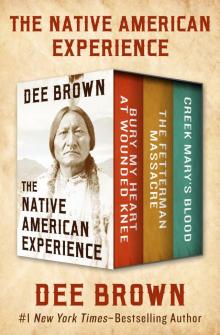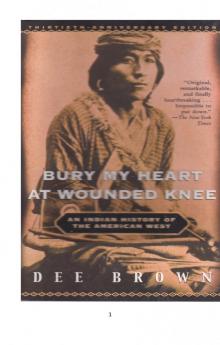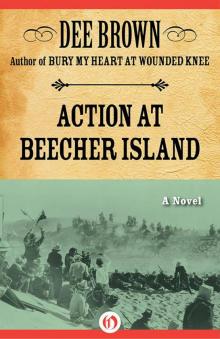The Native American Experience Read online
The Native American Experience
Bury My Heart at Wounded Knee, The Fetterman Massacre, and Creek Mary’s Blood
Dee Brown
CONTENTS
Bury My Heart at Wounded Knee
LIST OF ILLUSTRATIONS
PREFACE
INTRODUCTION
1. “THEIR MANNERS ARE DECOROUS AND PRAISEWORTHY”
2. THE LONG WALK OF THE NAVAHOS
3. LITTLE CROW’S WAR
4. WAR COMES TO THE CHEYENNES
5. POWDER RIVER INVASION
6. RED CLOUD’S WAR
7. “THE ONLY GOOD INDIAN IS A DEAD INDIAN”
8. THE RISE AND FALL OF DONEHOGAWA
9. COCHISE AND THE APACHE GUERRILLAS
10. THE ORDEAL OF CAPTAIN JACK
11. THE WAR TO SAVE THE BUFFALO
12. THE WAR FOR THE BLACK HILLS
13. THE FLIGHT OF THE NEZ PERCÉS
14. CHEYENNE EXODUS
15. STANDING BEAR BECOMES A PERSON
16. “THE UTES MUST GO!”
17. THE LAST OF THE APACHE CHIEFS
18. DANCE OF THE GHOSTS
19. WOUNDED KNEE
NOTES
BIBLIOGRAPHY
INDEX
The Fetterman Massacre
I. April:
MOON WHEN THE GEESE LAY EGGS
II. May:
PLANTING MOON
III. June:
MOON WHEN THE GREEN GRASS IS UP
1
2
IV. July:
MOON WHEN THE CHOKECHERRIES ARE RIPE
V. August:
MOON WHEN THE GEESE SHED THEIR FEATHERS
VI. September:
DRYING GRASS MOON
VII. October:
HARVEST MOON
VIII. November:
DEER RUTTING MOON
IX. December:
MOON WHEN THE DEER SHED THEIR HORNS
1
2
3
4
5
6
7
8
X. January
MOON OF STRONG COLD
XI. Aftermath
1
2
3
4
5
Bibliography
Notes
Index
Creek Mary’s Blood
Book One: The Easterners
1
2
3
4
5
6
7
8
9
10
11
12
13
14
15
16
17
18
19
20
21
22
23
24
25
Book Two: The Westerners
26
27
28
29
30
31
32
33
34
35
36
37
38
39
40
41
42
43
44
45
46
47
48
Book Three: The Survivors
49
50
51
52
53
54
55
56
57
58
59
Acknowledgements
A Biography of Dee Brown
Bury My Heart at Wounded Knee
An Indian History of the American West
For Nicolas Brave Wolf
Contents
LIST OF ILLUSTRATIONS
PREFACE
INTRODUCTION
1. “THEIR MANNERS ARE DECOROUS AND PRAISEWORTHY”
2. THE LONG WALK OF THE NAVAHOS
3. LITTLE CROW’S WAR
4. WAR COMES TO THE CHEYENNES
5. POWDER RIVER INVASION
6. RED CLOUD’S WAR
7. “THE ONLY GOOD INDIAN IS A DEAD INDIAN”
8. THE RISE AND FALL OF DONEHOGAWA
9. COCHISE AND THE APACHE GUERRILLAS
10. THE ORDEAL OF CAPTAIN JACK
11. THE WAR TO SAVE THE BUFFALO
12. THE WAR FOR THE BLACK HILLS
13. THE FLIGHT OF THE NEZ PERCÉS
14. CHEYENNE EXODUS
15. STANDING BEAR BECOMES A PERSON
16. “THE UTES MUST GO!”
17. THE LAST OF THE APACHE CHIEFS
18. DANCE OF THE GHOSTS
19. WOUNDED KNEE
A BIOGRAPHY OF DEE BROWN
NOTES
BIBLIOGRAPHY
INDEX
List of Illustrations
Chapter Two
1. Manuelito
2. Juanita, wife of Manuelito
3. Navaho warrior of the 1860’s
Chapter Three
4. Little Crow
5. Big Eagle
Chapter Four
6. Cheyenne and Arapaho Chiefs in Denver
7. Little Raven
8. George Bent and his wife Magpie
9. Edmond Guerrier
Chapter Five
10. Red Cloud
Chapter Six
11. Spotted Tail
Chapter Seven
12. Roman Nose
13. Tosawi
Chapter Eight
14. Donehogawa (Ely Parker)
Chapter Nine
15. Cochise
16. Eskiminzin 203
Chapter Ten
17. Captain Jack
Chapter Eleven
18. Satanta
19. Lone Wolf
20. Kicking Bird
21. Ten Bears
22. White Horse
23. Quanah Parker
Chapter Twelve
24. Sitting Bull
25. Gall
26. Two Moon
27. Hump
28. Crow King
29. Young-Man-Afraid-of-His-Horses
30. Little Big Man
31. Crazy Horse
Chapter Thirteen
32. Chief Joseph
Chapter Fourteen
33. Dull Knife
34. Little Wolf
Chapter Fifteen
35. Standing Bear
Chapter Sixteen
36. Ouray
37. Nicaagat (Jack)
38. Quinkent (Douglas)
39. Colorow
Chapter Seventeen
40. Geronimo
41. Naiche and his wife
42. Victorio
43. Nana
Chapter Eighteen
44. Wovoka, the Paiute Messiah
45. Kicking Bear
46. Short Bull
47. John Grass
Chapter Nineteen
48. Big Foot in death
49. Red Cloud in old age
Preface
AN ANCIENT TRADITION TELLS us that the interval between the birth of the parents and the arrival of their first offspring averages thirty years. We call that a generation. Thirty years ago, early in 1971, this book was born. And so now it is beginning its second generation.
As the first generation ends, it is almost a cliché to say that enormous changes have occurred during the time that has passed. Yet vast changes certainly have affected the present-day descendants of the old tribal prophets whose stories are told in these pages.
During the past generation, some tribal reservations have prospered, others have not.
There are now, and probably always will be, disagreements within tribes as to the direction their people should take. In spite of the many personal frustrations and difficulties young seekers of knowledge experience, it is no longer unusual to meet American-Indian lawyers, physicians, college professors, computer specialists, artists, writers, or members of almost any other profession or trade. Yet on some reservations there is still a shortage of proper places in which to live. And the county with the deepest poverty in the United States is still a tribal reservation.
Judging from letters I have received through the years, the readers who have given life to this book come from almost all the hundred or so ethnic groups that comprise this unique and awesome place called America. Small though the comparative number of American Indians is, almost all other Americans seem to have an earnest fascination for their history, their arts and literature, their attitude toward the natural world, and their philosophy of human existence.
And this wide interest exists beyond the borders of America into the lands of other people and other cultures. Name a small nation, one whose people have a history of past injustices and oppression, and this book will likely be in print there.
We rarely know the full power of words, in print or spoken. It is my hope that time has not dulled the words herein and that they will continue through the coming generation to be as true and direct as I originally meant them to be.
DEE BROWN
in the year 2000
Introduction
SINCE THE EXPLORATORY JOURNEY of Lewis and Clark to the Pacific Coast early in the nineteenth century, the number of published accounts describing the “opening” of the American West has risen into the thousands. The greatest concentration of recorded experience and observation came out of the thirty-year span between 1860 and 1890—the period covered by this book. It was an incredible era of violence, greed, audacity, sentimentality, undirected exuberance, and an almost reverential attitude toward the ideal of personal freedom for those who already had it.
During that time the culture and civilization of the American Indian was destroyed, and out of that time came virtually all the great myths of the American West—tales of fur traders, mountain men, steamboat pilots, goldseekers, gamblers, gunmen, cavalrymen, cowboys, harlots, missionaries, schoolmarms, and homesteaders. Only occasionally was the voice of an Indian heard, and then more often than not it was recorded by the pen of a white man. The Indian was the dark menace of the myths, and even if he had known how to write in English, where would he have found a printer or a publisher?
Yet they are not all lost, those Indian voices of the past. A few authentic accounts of American western history were recorded by Indians either in pictographs or in translated English, and some managed to get published in obscure journals, pamphlets, or books of small circulation. In the late nineteenth century, when the white man’s curiosity about Indian survivors of the wars reached a high point, enterprising newspaper reporters frequently interviewed warriors and chiefs and gave them an opportunity to express their opinions on what was happening in the West. The quality of these interviews varied greatly, depending upon the abilities of the interpreters, or upon the inclination of the Indians to speak freely. Some feared reprisals for telling the truth, while others delighted in hoaxing reporters with tall tales and shaggy-dog stories. Contemporary newspaper statements by Indians must therefore be read with skepticism, although some of them are masterpieces of irony and others burn with outbursts of poetic fury.
Among the richest sources of first-person statements by Indians are the records of treaty councils and other formal meetings with civilian and military representatives of the United States government. Isaac Pitman’s new stenographic system was coming into vogue during the second half of the nineteenth century, and when Indians spoke in council a recording clerk sat beside the official interpreter.
Even when the meetings were in remote parts of the West, someone usually was available to write down the speeches, and because of the slowness of the translation process, much of what was said could be recorded in longhand. Interpreters quite often were half-bloods who knew spoken languages but seldom could read or write. Like most oral peoples they and the Indians depended upon imagery to express their thoughts, so that the English translations were filled with graphic similes and metaphors of the natural world. If an eloquent Indian had a poor interpreter, his words might be transformed to flat prose, but a good interpreter could make a poor speaker sound poetic.
Most Indian leaders spoke freely and candidly in councils with white officials, and as they became more sophisticated in such matters during the 1870’s and 1880’s, they demanded the right to choose their own interpreters and recorders. In this latter period, all members of the tribes were free to speak, and some of the older men chose such opportunities to recount events they had witnessed in the past, or to sum up the histories of their peoples. Although the Indians who lived through this doom period of their civilization have vanished from the earth, millions of their words are preserved in official records. Many of the more important council proceedings were published in government documents and reports.
Out of all these sources of almost forgotten oral history, I have tried to fashion a narrative of the conquest of the American West as the victims experienced it, using their own words whenever possible. Americans who have always looked westward when reading about this period should read this book facing eastward.
This is not a cheerful book, but history has a way of intruding upon the present, and perhaps those who read it will have a clearer understanding of what the American Indian is, by knowing what he was. They may be surprised to hear words of gentle reasonableness coming from the mouths of Indians stereotyped in the American myth as ruthless savages. They may learn something about their own relationship to the earth from a people who were true conservationists. The Indians knew that life was equated with the earth and its resources, that America was a paradise, and they could not comprehend why the intruders from the East were determined to destroy all that was Indian as well as America itself.
And if the readers of this book should ever chance to see the poverty, the hopelessness, and the squalor of a modern Indian reservation, they may find it possible to truly understand the reasons why.
Urbana, Illinois
April, 1970
Dee Brown
I shall not be there. I shall rise and pass. Bury my heart at Wounded Knee.
—STEPHEN VINCENT BENET
ONE
“Their Manners Are Decorous and Praiseworthy”
Where today are the Pequot? Where are the Narragansett, the Mohican, the Pokanoket, and many other once powerful tribes of our people? They have vanished before the avarice and the oppression of the White Man, as snow before a summer sun.
Will we let ourselves be destroyed in our turn without a struggle, give up our homes, our country bequeathed to us by the Great Spirit, the graves of our dead and everything that is dear and sacred to us? I know you will cry with me, “Never! Never!”
—TECUMSEH OF THE SHAWNEES
IT BEGAN WITH CHRISTOPHER Columbus, who gave the people the name Indios. Those Europeans, the white men, spoke in different dialects, and some pronounced the word Indien, or Indianer, or Indian. Peaux-rouges, or redskins, came later. As was the custom of the people when receiving strangers, the Tainos on the island of San Salvador generously presented Columbus and his men with gifts and treated them with honor.
“So tractable, so peaceable, are these people,” Columbus wrote to the King and Queen of Spain, “that I swear to your Majesties there is not in the world a better nation. They love their neighbors as themselves, and their discourse is ever sweet and gentle, and accompanied with a smile; and though it is true that they are naked, yet their manners are decorous and praiseworthy.”
All this, of course, was taken as a sign of weakness, if not heathenism, and Columbus being a righteous European was convinced the people should be “made to work, sow and do
all that is necessary and to adopt our ways.” Over the next four centuries (1492–1890) several million Europeans and their descendants undertook to enforce their ways upon the people of the New World.
Columbus kidnapped ten of his friendly Taino hosts and carried them off to Spain, where they could be introduced to the white man’s ways. One of them died soon after arriving there, but not before he was baptized a Christian. The Spaniards were so pleased that they had made it possible for the first Indian to enter heaven that they hastened to spread the good news throughout the West Indies.
The Tainos and other Arawak people did not resist conversion to the Europeans’ religion, but they did resist strongly when hordes of these bearded strangers began scouring their islands in search of gold and precious stones. The Spaniards looted and burned villages; they kidnapped hundreds of men, women, and children and shipped them to Europe to be sold as slaves. Arawak resistance brought on the use of guns and sabers, and whole tribes were destroyed, hundreds of thousands of people in less than a decade after Columbus set foot on the beach of San Salvador, October 12, 1492.
Communications between the tribes of the New World were slow, and news of the Europeans’ barbarities rarely overtook the rapid spread of new conquests and settlements. Long before the English-speaking white men arrived in Virginia in 1607, however, the Powhatans had heard rumors about the civilizing techniques of the Spaniards. The Englishmen used subtler methods. To ensure peace long enough to establish a settlement at Jamestown, they put a golden crown upon the head of Wahunsonacook, dubbed him King Powhatan, and convinced him that he should put his people to work supplying the white settlers with food. Wahunsonacook vacillated between loyalty to his rebellious subjects and to the English, but after John Rolfe married his daughter, Pocahontas, he apparently decided that he was more English than Indian. After Wahunsonacook died, the Powhatans rose up in revenge to drive the Englishmen back into the sea from which they had come, but the Indians underestimated the power of English weapons. In a short time the eight thousand Powhatans were reduced to less than a thousand.
In Massachusetts the story began somewhat differently but ended virtually the same as in Virginia. After the Englishmen landed at Plymouth in 1620, most of them probably would have starved to death but for aid received from friendly natives of the New World. A Pemaquid named Samoset and three Wampanoags named Massasoit, Squanto, and Hobomah became self-appointed missionaries to the Pilgrims. All spoke some English, learned from explorers who had touched ashore in previous years. Squanto had been kidnapped by an English seaman who sold him into slavery in Spain, but he escaped through the aid of another Englishman and finally managed to return home. He and the other Indians regarded the Plymouth colonists as helpless children; they shared corn with them from the tribal stores, showed them where and how to catch fish, and got them through the first winter. When spring came they gave the white men some seed corn and showed them how to plant and cultivate it.

 The Native American Experience
The Native American Experience Bury My Heart At Wounded Knee
Bury My Heart At Wounded Knee Action at Beecher Island: A Novel
Action at Beecher Island: A Novel Saga of the Sioux
Saga of the Sioux